This article about flying with an infant on your lap is written by certified Child Passenger Safety Technician Melissa Conn and may contain affiliate links.
If you want to see the keyboard warriors and mom-shamers come out in full force, jump on social media and ask if you should buy a plane ticket for your baby or take her as a lap infant on an airplane. It’s a hot topic for sure!
I certainly have opinions on what parents should do in an ideal world. But we were all perfect parents until we had kids, right? In this article I’ll go over what you should think about if you’re considering flying with an infant on lap, lap baby safety, costs of a lap infant vs seat infant and the comfort issues of flying with a lap baby.
Why flying with an infant on lap is allowed

There are two big reasons why flying with an infant on lap is allowed today.
First, airlines have successfully lobbied to keep the option available. It keeps those flights to Orlando (and other kid-friendly destinations) full of families traveling with little kids who might otherwise find the cost of a flying vacation out of reach. We know many families who traveled more when their kids were babies because they didn’t have to buy seat.
Second, flying is still safeER than driving. If more families hit the road for their vacation, there would likely be more kids hurt than if those same families flew according to the Federal Aviation Administration and the National Highway Traffic Safety Administration.
Ok, so it’s allowed. But should you bring a lap baby on an airplane?
Lap child safety considerations
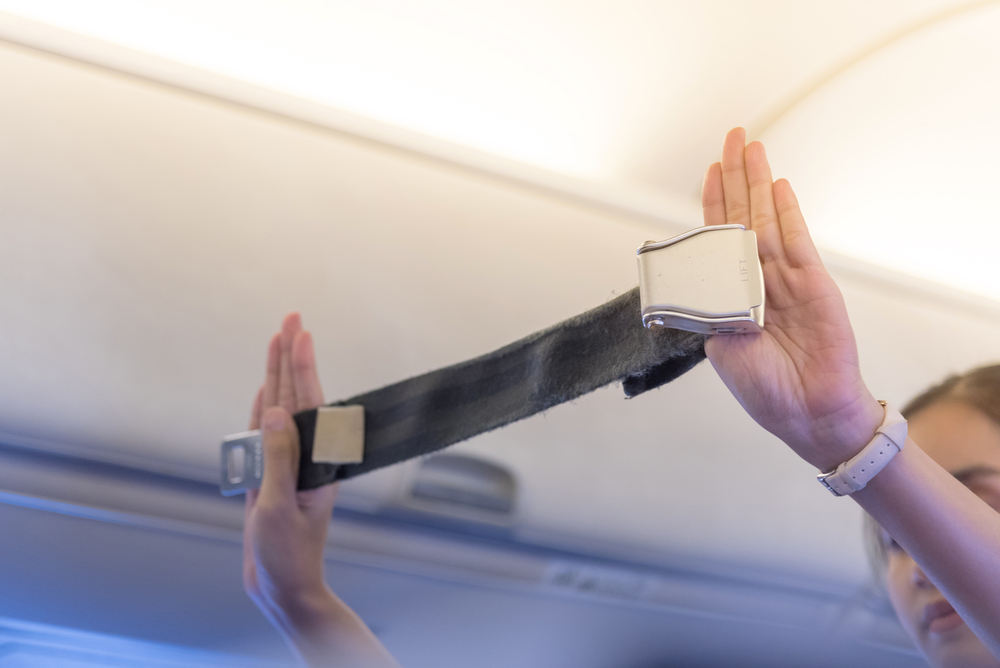
Safety is the foremost concern for every parent. There’s no denying that it’s safer to have a baby ride in a car seat on a plane than to try to hold them in your arms during a runway accident or turbulence. Check out this compelling crash test video provided by the FAA to simulate what can happen when you have a lap child during severe turbulence:
Fortunately plane crashes are extremely rare. The most common injuries for babies on flights less headline-worthy, but still traumatic for the families involved: burns from hot drinks, falls from their parents arms, and incidents related to service carts.
The risks of many of those injuries can be completely eliminated by having a child in their own seat and restrained in either a travel car seat or the CARES harness. In addition to keeping a child from falling or squirming into the aisle, car seats are generally installed in the window seat and don’t have the same “aisle exposure”.
In some countries, children under 2 years old (even if they have a purchased ticket and a car seat) are required to be attached to their parents with a lap baby seat belt (also called a “belly belt”) for take off and landing. Those devices are illegal in the US and Canada because they introduce different risks like a parent accidentally crushing their baby or the baby hitting its head on the seat in front. There’s often enough slack in the belly belt that a wiggly baby could still fall and hit her head.
If you’re considering splurging on premium two seats instead of three economy seats, take note of the type of seatbelts on the plane. Many premium aircraft cabins now have inflatable seatbelts, which the manufacturer recommends against using with lap children due to safety concerns.
Read more: Important info for traveling with car seats
Some parents like to use a baby carrier on flights. They aren’t allowed for take off and landing because a parent can crush their baby. Some flight attendants will allow you to use a baby carrier during turbulence, but others won’t because of the safety risk.
The other safety challenge when it comes to bringing a lap infant on an airplane is what you’ll do with the car seat if you need to bring it for travel at your destination. Checking a car seat comes with quite a few risks that are worth evaluating.
Lap baby cost difference
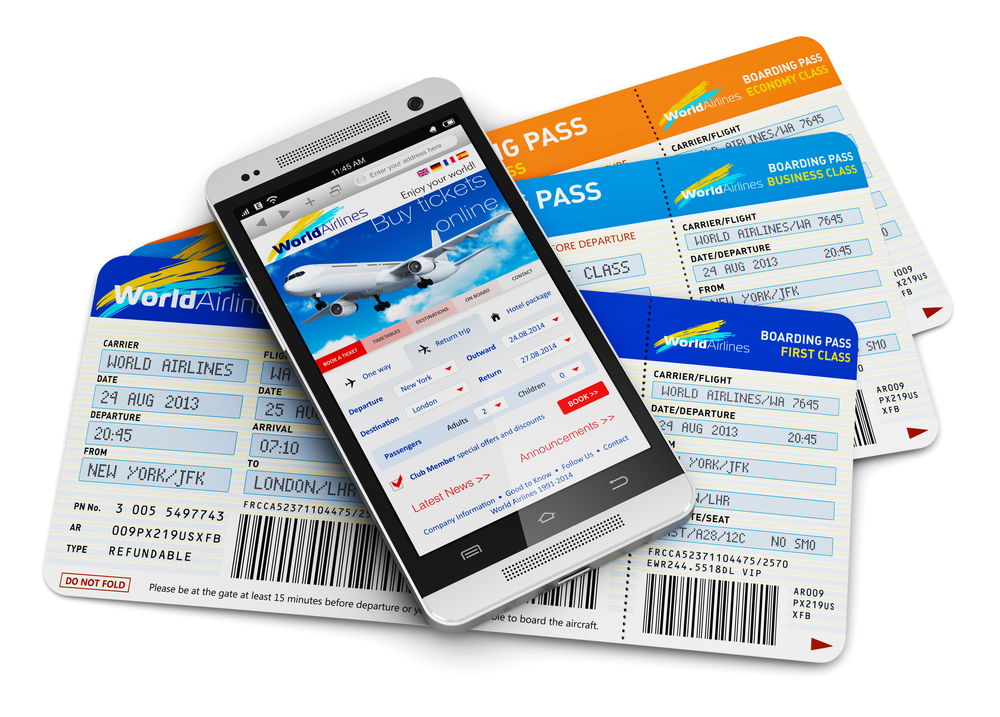
Why do so many parents end up flying with a lap infant? Money.
In the US, generally infants can fly completely free with a ticketed adult. Tempting, eh? If that’s your main motivation for not buying baby a plane ticket, check out the companion passes from Southwest Airlines and Alaska Airlines or the Discount Den from Frontier Airlines for free or deeply discounted plane tickets for kids.
When you’re flying internationally, it’s a different ballgame. International lap infant plane tickets usually cost just 10% of the adult base fare! Woohoo!!! But you’re still on the hook for up to 100% of the taxes and fees. The portion depends on the airline, which countries you’re flying into and out of and even where you might have a layover.
On the other hand, many international carriers give a discount on child tickets too – we’ve usually seen around 10%. It’s not as generous, but helps to close some of the gap.
Definitely price out tickets for seat infant vs lap infant before deciding. On one 15 hour flight we took, the difference was just a few hundred dollars. While that’s a meaningful amount of money, it was small compared to the total travel cost for our family.
Even if you haven’t bought a ticket for your child, often if there’s an empty seat on a flight the crew will let you use it with your car seat since it’s safer for everyone. That’s yet another reason not to check your car seat!
Lap infant comfort comparison

For many families, comfort on the flight pushes them toward flying with a lap baby or buying their baby a seat – and there isn’t a right answer on this one! Every kid and every parent has different preferences. Here are a few options for flying with a baby:
Hold baby in your lap
For some parents, they love this option from a comfort perspective. Maybe they plan on nursing during flights or their baby will only sleep while being held. No matter how much you love snuggling with your baby, if it’s a long flight this is probably the least comfortable option (and can be dangerous if you plan to fall asleep).
Some parents bring one of these to give their baby a cozy place to lay down and relieve some of the arm strain, though that probably only works if you have two adults traveling next to each other. If you’re traveling solo with a lap baby, this one won’t offer as much support but could help if it’s a long flight.
There are certainly parents who bring their kids as lap children up through 23 months and 29 days. In most cases, that’s an awfully big kid to hold (and physically restrain) for a long time. In the era of shrinking airplane legroom, it’s worth thinking about whether or not it will be comfortable for either of you – and how you’ll prevent your child from kicking the seat in front of them when legroom is in short supply.
Squirmy babies of any age may not make for great lap infants. If they like to jump all over you, pull your hair, refuse to be held still during turbulence – you may need a glass of wine, but you probably won’t have the hands or personal space to manage it!
Whether or not the comfort issue matters to you might depend on the situation. If it’s a long night flight crossing many time zones to a different continent, it might be more important to you to get some extra sleep even if it means spending more money. On the other hand, for a short flight to visit family the cramped space might be more tolerable.
And lets not talk about how you’re going to manage that tray table during meal service…
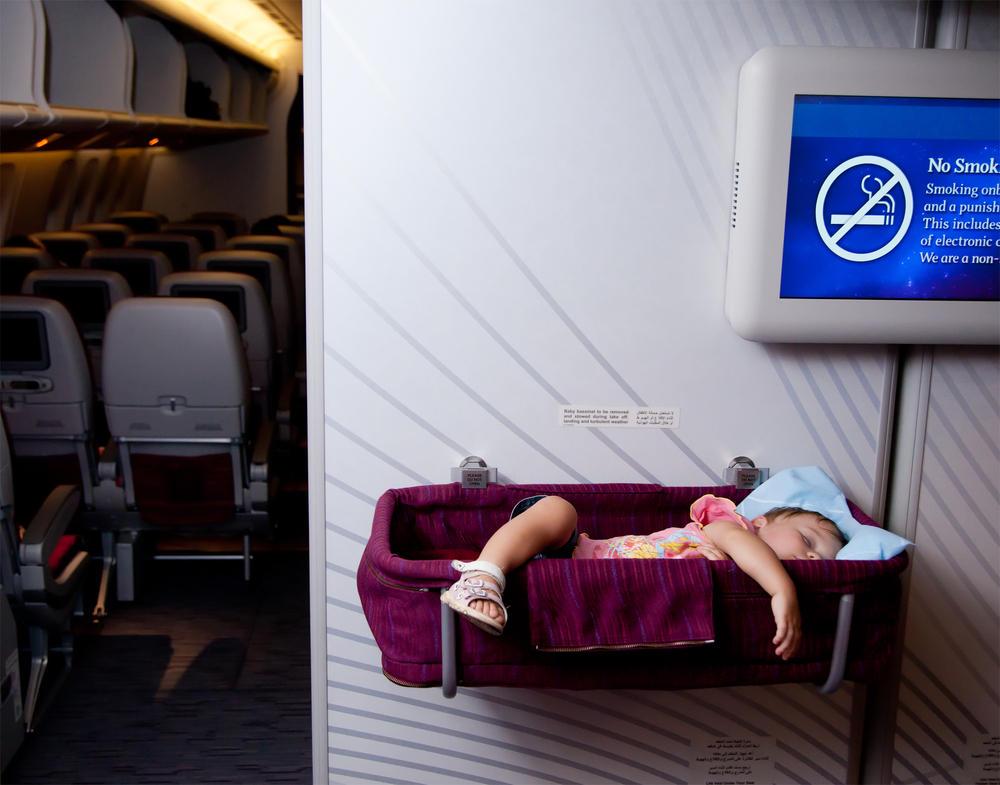
Use an airline bassinet for baby
Bassinets are usually only available on international flights (sometimes you can snag one on a domestic flight that’s part of a longer overseas route), where they attach to the bulkhead. There are only a few on each flight and they’re a hot commodity.
Some airlines will reserve one for you if you call as soon as you buy your plane ticket, but usually they’re either first-come-first-served at the airport or the airline prioritizes the youngest babies. So you might think you have a bassinet booked for your 6 month old baby but then find out that a family with a 1 month old bumped him the day before the flight. And there’s not much you can do about it.
Like the babies that ride in them, bassinets vary in size: some are outgrown at 4 months old, others will hold small toddlers! But usually you aren’t supposed to use them if your child can sit themselves up, since they could easily tumble out.
Bassinets aren’t considered a safety restraint, just a comfortable spot for your baby. What does that mean? If you hit a patch of turbulence in the middle of the night, you have to take your baby out of the bassinet. You know that thing people say about “never wake a sleeping baby”?
Airlines may also have specific rules about exactly how you use the bassinet. At least one airline won’t let you put even a blanket in the bassinet with your child, while yet another requires that you enclose your child fully in the bassinet with the attached mesh panel. Yikes!
If you buy an infant plane ticket, you have two safe options to consider.
CARES harness + (optional) inflatable pillow
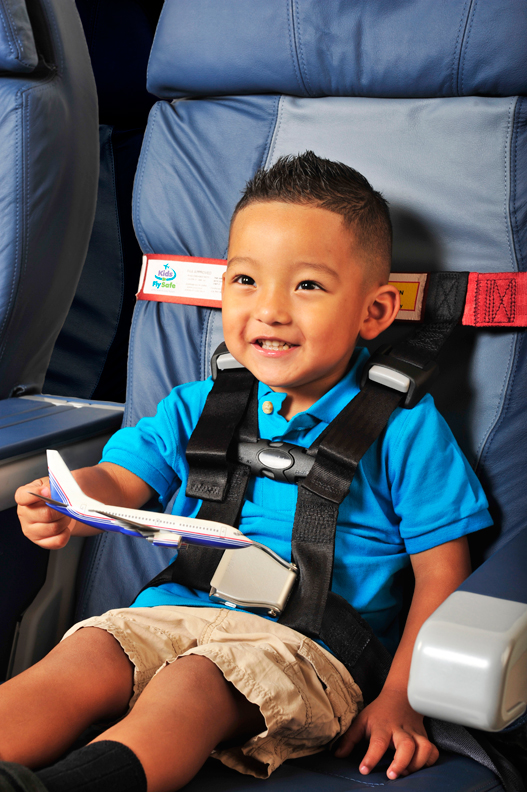
The CARES harness is an FAA-approved restraint that adds shoulder harnesses and a chest clip to the airplane seatbelt, turning it into a 4-point harness (there’s no crotch strap, which sets it apart from a car seat). The CARES harness is approved for 22-40 pounds and up to 40″, but most parents report that it doesn’t fit well until 30 pounds.
Read more: Should you buy the CARES harness? In-depth review
The CARES child restraint works best for kids who are not only heavy enough, but also strong enough to sit independently for the whole flight. It’s not designed for babies, but more for young toddlers (including those who are under 2 and still technically eligible for lap baby status but are big enough to fit well).
It’s also best for kids who aren’t too fidgety. Airplane seatbelts are extremely easy for curious little ones to open on their own, even by accident. Toddlers under 30 pounds can also wiggle under the lap belt, referred to as “submarining”. You can limit that with a rolled towel under their knees to help them stay propped up.
One big downside of little kids using the CARES harness for a long flight is that they might not be comfortable for sleep. Airplane seats offer just a little bit of recline, while most kids are used to sleeping completely flat from birth to age 2.
If you do opt for the CARES harness for a child who is closer to the upper size range, you can consider pairing it with one of these for extra comfort. Not every airline allows them so you’ll need to check before you fly. But they can be a great addition and you’ll keep using for years to come, even when your child passes 40 pounds and doesn’t need a car seat on board anymore.
Bring a car seat

For both safety and comfort, our preferred option is to bring a travel car seat on the plane. Little babies who are used to riding in their car seats will love the comfortable familiarity – there are some specialized travel infant car seats and lightweight infant car seats that will make travel even easier. Rear-facing car seats (which are recommended until at least age 2, but ideally longer) are perfectly reclined for kids to sleep. Car seats are also the safest option for kids up to 40 pounds. Check out these travel car seats for 1 year olds and travel car seats for 2 year olds to find one that’s easy to lug through the airport and use on the plane.
The biggest downside of flying with an infant in a car seat is how to deal with nursing. You’ll need to buckle your child for take-off and landing, as those are the most dangerous times during the flight. Once your child is a little older, she might need more time (when the seatbelt sign is off) to crawl around her car seat, stand a bounce on your lap or go for walks on the plane.
But here’s the good news: the time on the tarmac isn’t when your baby will feel uncomfortable from the changing air pressure. That usually happens about 10 minutes after take-off or 10-20 minutes before landing. At those times it’s generally safe to take your baby out to nurse. Alternatively, you can offer a pacifier for a little baby or some puffs to chew on for an older baby.
Lap infant vs seat infant: what should you do?
Once you know the pros and cons of traveling with a lap infant, it can be even harder to decide how to travel with your little one. While we traveled a handful of times with a lap baby before we realized the safety risks for our kid (and his car seat), we opted to change course once we had more experience and knowledge under our belts. As you can tell by the name of this website, we’re advocates for buying plane tickets for babies and restraining them safely!
Infant on lap vs infant on seat FAQs
A lap infant is a child under 2 years old who flies without his or her own seat.
Booking an infant airplane seat is the safest way to fly with a baby. It protects your child from runway incidents and severe turbulence. If you’re bringing a car seat for your trip, bringing it on board for your baby to use prevents the car seat from being lost or damaged while checked.
Infants are injured every year when traveling as lap babies and in greater numbers than infants traveling in their own seats. That said, flying with a baby on lap is statistically safer than driving. That’s why the FAA strongly recommends using an infant seat in flight but doesn’t currently require it – government agencies are concerned that the addition infant flight ticket cost would push more families to drive.
A child can travel as a baby in lap until the day before her 2nd birthday. On her 2nd birthday, she needs to have her own seat.
If you’ll be flying one leg before her birthday and flying the other leg after her birthday, she needs a seat for the whole itinerary (unless you book two one-way tickets, in which case only the leg after her birthday requires a ticket). Regardless of age, the safest choice is to buy even young babies their own plane ticket and bring their car seat on board.
No, babies under 2 do not fly free internationally. Buying a seat for baby usually carries a 10% discount off the base fare, while an infant in lap usually pays 10% of the base fare. In both cases, the full taxes and fees are generally assessed. For some international tickets, those taxes and fees can be more than the base far – so the financial savings aren’t as big as they initially appear.
Absolutely! That’s the FAA’s recommendation. It’s safest to use an infant seat in flight (or a convertible car seat if that’s what you have, though they can be tougher to fit) if your child is under 40 pounds. For kids between 30 and 40 pounds who can sit independently, you can consider the CARES harness (full review here). Note that some airlines require the use of a car seat or CARES if you’re booking a seat for your child under 2 years old – it’s for their safety and the safety of everyone else on board.
Flying with twins is no laughing matter! If you’re thinking about taking your twins as lap infants, know that you’ll be limited by the number of oxygen masks in the row. Each bank of three seats typically has four oxygen masks, so two adults each traveling with a twin as an infant on lap will need to sit apart from each other. Usually you can sit across the aisle from each other.
Did you find this helpful? Pin it to share with others!
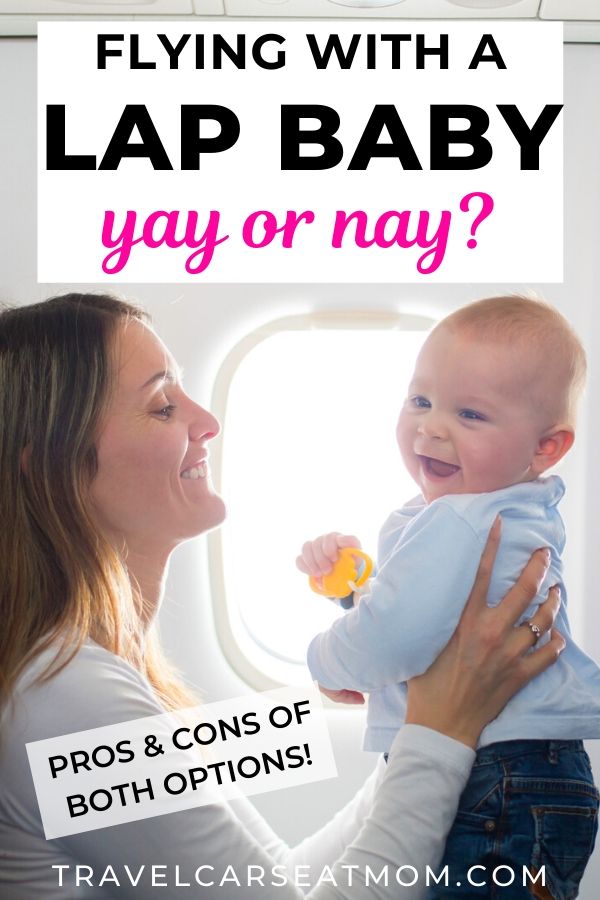
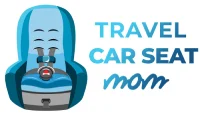
Helpful article. Good points and suggestions.
However I’m still undecided.
If I buy a seat for baby can I still choose to hold her to nurse with take off & landing?
Hi Kaycie,
Thanks for stopping by! That will depend on the flight crew. If a child has a seat, ideally they will sit in it. Take off and landing are the most dangerous time of a flight. The good news if you’re concerned about air pressure change impacting her ears is that the pressure change is really much more of an issue about 10 minutes after take off and 15 minutes before landing. You could take her out for a quick milk snack at those times without risking her safety on the ground. Alternatively, some families bring a small bottle for expressed milk (or water, if over 6 months) to help ease the pressure change.
I hope these tips help!
Safe travels,
Melissa
Great article!
How do I purchase a seat for an infant under 2 years old? Choose “Age 2-17” option?
Hi Max,
Thanks for stopping by! If the airline doesn’t give the option to buy a seat for your infant, I’d just choose 2-17. Be sure to double-check their car seat policy in advance – some international carriers don’t permit rear facing car seats unfortunately. When our kids were little we refused to fly with those carriers and only flew airlines that allowed us to seat our children safely.
Safe travels,
Melissa
Thank you for this in-depth information!
Do you leave your children strapped in for the entire flight? We are using the CARES system but on a 12 hour flight, we’d consider only using the harness during the times when the seatbelt sign is on, so that he can stretch out to sleep.
Is that unsafe?
Hi Jane,
Everyone must be buckled in for take-off/landing/taxi and turbulence. However, flight crews generally request (or require) that you be buckled when going to sleep because you NEVER know when severe turbulence will come up. It’s fine to unbuckle to take a quick walk in the aisle when the coast is clear but I really don’t recommend having your child lay down to sleep unsecured. One of the benefits of bringing a rear facing car seat on a plane is that the kiddo can be reclined and sleep uninterrupted even if there’s unexpected turbulence.
Safe travels,
Melissa
Thank you for sharing such useful information. I’m strongly leaning towards buying the seat for my 7-month-old since it’s safest. My only worry is how long a baby should be in a car seat. The longest leg of my trip is 8 hours (overnight during his sleeping time) and I remember reading that a baby shouldn’t be in a car seat for more than 2 hours or sleep in it. Is this ok since it’s a one-off situation? or what do you do about time in the car seat? Thank you!
Hi Midori,
Thanks for stopping by! At 7 months old, your baby will be ok asleep in the car seat next to you. When baby is awake, it’s a great idea for you to both get up and stretch your legs at least every two hours.
Safe travels,
Melissa
Hi Melissa!
If the child is under age (18 months) isn’t it a risk to choose the 2-17 option to buy the seat? We really do NOT want to carry him on a 15 hour flight, but it’s a lot scarier if they don’t allow him to board because we “lied” on the ticket
Hi Fernando,
They shouldn’t deny you boarding because you have purchased a ticket for your infant and brought a car seat on board. If you’re concerned, I recommend either calling to purchase your ticket OR purchasing and then calling within the 24 hour “cooling off” period to update the reservation to reflect your child’s real age.
There are some non-US carriers that don’t allow any rear facing car seats, which is terrible policy for kids under 2. Our family opted not to fly those airlines at all until our children were old enough and big enough to safely forward face for the flight (even though they continued to rear face longer in the car).
I hope this helps!
Safe travels,
Melissa